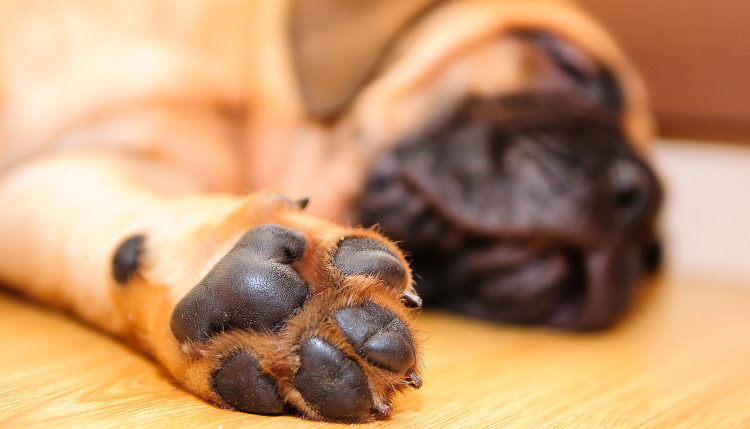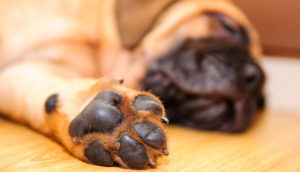Photo by yousafbhutta on Pixabay
As a dogs owner, you may have noticed a peculiar scent emanating from your furry friend’s paws. It’s an aroma that has been described as resembling corn chips, popcorn, or even Fritos. While this may seem unusual, rest assured that it’s a common occurrence and usually nothing to be concerned about. In this article, we’ll delve into the reasons behind this intriguing phenomenon and explore what you can do to keep your dog’s paws smelling fresh and healthy.
The Science Behind the Corn Chip Smell
The first question that comes to mind is what exactly causes the corn chip smell in your dog’s paws? The answer lies in the naturally occurring bacteria that reside on their paw pads. These bacteria, specifically Proteus and Pseudomonas, emit a yeasty odor, which is responsible for the distinctive smell. It’s important to note that this odor is a normal and natural part of your dog’s physiology, so there’s no need to worry.
When the Smell Takes a Turn for the Worse
While the corn chip smell is generally harmless, there are instances where the odor can become less pleasant. Dogs, like humans, sweat through their feet, and if the sweat becomes trapped in the fur between their paw pads, it can create a more pungent smell. In such cases, it’s advisable to trim the fur between the paw pads to allow the sweat to dissipate and prevent it from permeating further into the fur.
To trim the fur, use hair clippers and exercise caution to avoid any accidental cuts or injuries. Once you’ve trimmed the fur, it’s time for a thorough bath. Lather each of your dog’s paws with pet shampoo, ensuring you reach all the nooks and crannies, to remove any sweat and debris. Rinse the paws thoroughly to eliminate any remaining shampoo residue. This simple hygiene routine should help eliminate the undesirable odor.
When to Seek Veterinary Assistance

In most cases, the corn chip smell and even the slightly stronger sweat odor are perfectly normal. However, there are situations where a foul stench from your dog’s paws may indicate a more serious underlying problem. It’s important to keep an eye out for any additional signs that may accompany the odor. These signs include dry, flaky skin on the paw pads, cracked or flaky toenails, redness, itching, hair loss, drainage from the paw pad, and limping or favoring other legs.
If your dog is exhibiting any of these symptoms alongside an exceptionally foul smell, it’s advisable to consult your veterinarian. These signs may be an indication of an overgrowth of pathologic microbes on the paw pads, leading to a bacterial or fungal infection. There could also be a foreign body, such as a grass awn, causing irritation or an abscess. In some cases, an injured toenail or infection in the nail bed could be the underlying issue. A veterinarian will be able to provide a proper diagnosis and recommend the appropriate treatment.
Maintaining Healthy Paw Pads
To ensure your dog’s paw pads stay healthy and odor-free, it’s essential to establish a regular paw care routine. This routine should include regular inspections for any signs of inflammation, cuts, or foreign objects. Additionally, keep your dog’s paw pads moisturized to prevent dryness and cracking.
One effective way to moisturize your dog’s paw pads is by applying a paw balm or moisturizer specifically designed for dogs. These products help to nourish the skin and provide a protective barrier against environmental factors. Be sure to choose a product that is safe for dogs and free from any harmful ingredients.
Another crucial aspect of paw pad care is proper nail maintenance. Overgrown nails can cause discomfort and affect your dog’s gait, leading to potential paw pad injuries. Regular nail trimming is essential to prevent such issues. If you’re unsure about how to trim your dog’s nails safely, consult a professional groomer or your veterinarian for guidance.
Additional Tips for Paw Health
In addition to the basic paw care routine, there are a few extra measures you can take to promote optimal paw health for your furry companion:
- Regular exercise: Regular exercise helps keep your dog’s paw pads strong and resilient. It also helps to maintain a healthy weight, reducing the strain on their feet.
- Proper nutrition: A balanced diet plays a vital role in maintaining overall health, including the health of your dog’s paws. Ensure your dog’s diet is rich in essential nutrients, such as omega-3 fatty acids, which contribute to healthy skin and coat.
- Avoid harsh chemicals: When cleaning your floors or surfaces, opt for pet-friendly cleaning products. Harsh chemicals can irritate your dog’s paws and potentially lead to skin issues.
- Protect from extreme temperatures: Extreme temperatures, whether hot or cold, can be tough on your dog’s paws. During hot weather, avoid walking your dog on hot pavement, as it can cause burns. In colder weather, provide your dog with booties or paw wax to protect their paws from ice and salt.
By incorporating these additional tips into your dog’s routine, you can help ensure their paw pads remain healthy, comfortable, and free from any unpleasant odors.

Conclusion
The corn chip smell emanating from your dog’s paws is a normal and natural occurrence caused by bacteria that reside on their paw pads. This scent is typically harmless and nothing to be concerned about. However, it’s important to be aware of any accompanying signs that may indicate a more serious issue. Regular paw care, including trimming fur, proper hygiene, and regular inspections, will help maintain the health of your dog’s paws. Remember, if you notice any concerning symptoms or an exceptionally foul odor, don’t hesitate to seek veterinary assistance. With a little extra care and attention, your dog’s paws will remain happy, healthy, and smelling fresh.

